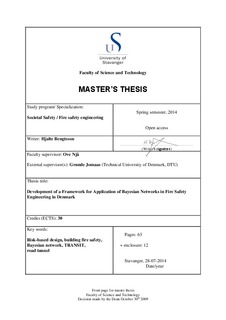| dc.description.abstract | Studies have found that deterministic performance-based fire safety design leads to unnecessary high safety levels in buildings in Denmark. Other studies have described that prescribed fire safety regulations leads to safety levels that vary based on the type of occupancy and the type of fire safety concept. Additionally, it has been found that designers do not focus on the safety margin of designs, which leads to further inconsistency in the safety levels of different buildings. These issues are problematic for building developers and building users as resources are wasted on fire safety installations and systems that are not necessarily required.
A risk-based design approach has been suggested as a solution to the problems. However, risk-based methods require reliable models and data to adequately describe the safety level of a building. The first goal of the present study was to assess the potential of using Bayesian networks to improve current fire risk analysis methods.
The study found that Bayesian networks have significant advantages compared to the tools currently used in fire safety engineering in Denmark — for example fault and event trees. The advantages include the enhanced ability to model interconnected phenomena and the possibility to model variables more detailed than a mere binary representation. Based on these qualities, the study found that the use of Bayesian networks could improve fire risk analyses.
However, it was also found that amethodology for successful application of Bayesian networks in fire safety engineering has not been developed. Therefore, the second goal of this study was to develop a framework for the application of Bayesian network models in fire safety engineering.
The framework was developed based on different Bayesian network models for use in fire risk analysis found in the literature. However, these models were not deemed adequate to describe all the challenges regarding implementation of a new tool in practice. Therefore, it was investigated how a state of the art Bayesian network model called TRANSIT has been applied in assessment of road tunnel safety.
TRANSIT was found to be a holistic model with focus on both incident occurrence and consequences. The model was evaluated based on a complex road tunnel called Rogfast in order to test the limitations of TRANSIT. The evaluation showed that there was some fundamental flaws in the model, for example in the way the model handles uncertainty. Despite this, several concepts used in TRANSIT were found to be applicable for fire safety engineering purposes. These concepts included how to spilt a building in segments with a uniform risk level and how to combine different parameters in a central factor in order to easier model for example occurrence of unwanted events.
Based on the evaluation of TRANSIT and the Bayesian network models found in the literature, 19 recommendations to the use of Bayesian networks in fire safety engineering was formulated. These recommendations formthe basis of the framework. The recommendations was separated in four main categories: (i) Categorisation and limitation ofmodels, (ii) key variables to include, (iii)modelling methods and (iv) methods for handling uncertainty. The full list of recommendations is seen in table 5.2 on page 56.
In closing, it was found that explicit acceptance criteria are needed in order to maximise the potential of risk-based methods in fire safety engineering. In Denmark, there is currently no such criteria, thus, for the time being Bayesian Network models can only be used to compare the risk level in different buildings or to model failure of sub-systems or processes. | nb_NO |

